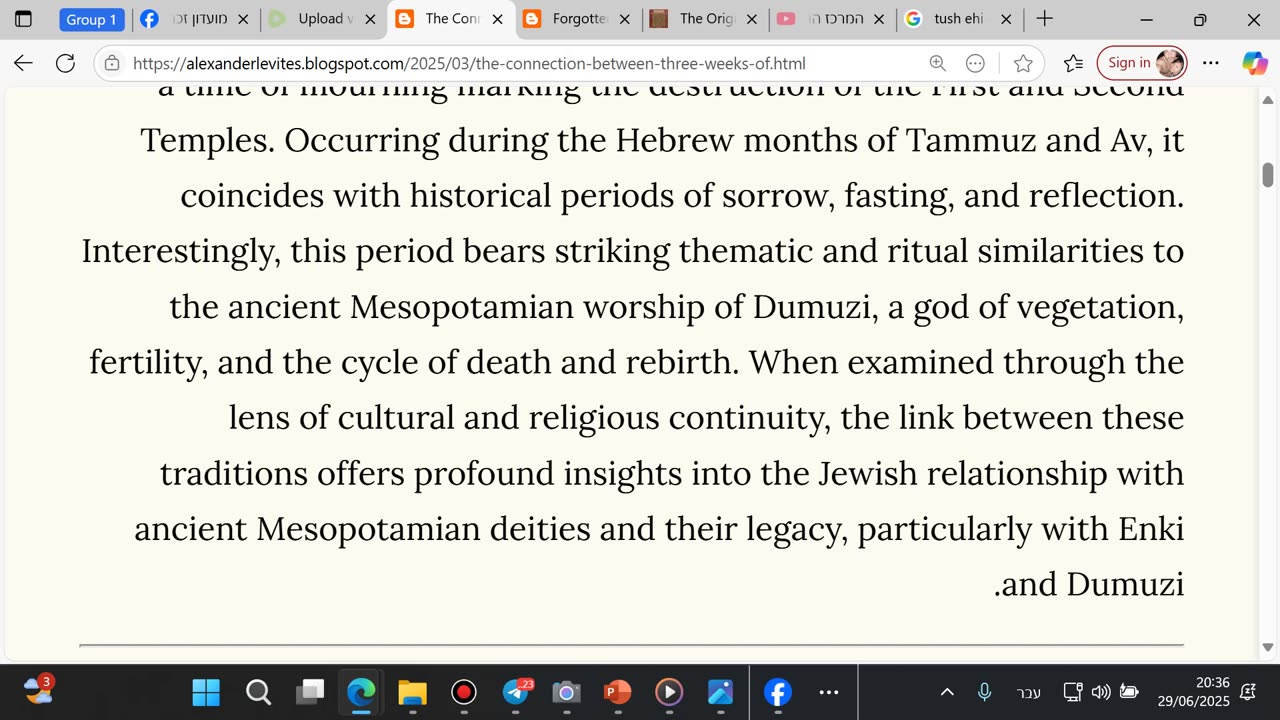Premium Only Content

The Connection Between the “Three Weeks” of Mourning in Judaism and the Worship of Dumuzi
https://alexanderlevites.blogspot.com/2025/03/the-connection-between-three-weeks-of.html
The Jewish period known as the "Three Weeks," or "Bein HaMetzarim," is a time of mourning marking the destruction of the First and Second Temples. Occurring during the Hebrew months of Tammuz and Av, it coincides with historical periods of sorrow, fasting, and reflection. Interestingly, this period bears striking thematic and ritual similarities to the ancient Mesopotamian worship of Dumuzi, a god of vegetation, fertility, and the cycle of death and rebirth. When examined through the lens of cultural and religious continuity, the link between these traditions offers profound insights into the Jewish relationship with ancient Mesopotamian deities and their legacy, particularly with Enki and Dumuzi.
1. Dumuzi: The Beloved Son of Enki
Who Was Dumuzi?
Dumuzi, also known as Tammuz in later traditions, was the god of fertility, vegetation, and the natural cycles of death and rebirth in the Sumerian pantheon. He was the son of Enki, the god of wisdom, water, and creation, and was deeply associated with renewal and survival in the harsh realities of ancient agriculture.
Dumuzi's annual death, descent to the underworld, and eventual rebirth symbolized the withering and revival of life in nature. His myth was central to communal rituals of mourning, kinos (laments), and hopes for rejuvenation.
Prototype of the Jesus Figure
The archetype of Dumuzi prefigures the role of Jesus in Christian tradition:
Both are figures who undergo death and rebirth for the benefit of humanity.
Both are mourned in rituals marking their suffering (akin to the communal mourning for Dumuzi during Tammuz).
The shared themes of sacrifice, resurrection, and hope link these figures across cultures and religions.
This connection highlights the cultural interplay between Mesopotamian traditions and later religious frameworks.
2. Dumuzi’s Connection to Jewish Traditions
Tammuz and the Hebrew Calendar
The name of the Hebrew month Tammuz is directly borrowed from the Akkadian name of the god Dumuzi, underscoring the cultural overlap. The mourning rituals of “Bein HaMetzarim” occur in this month, paralleling the ancient lamentations for Dumuzi.
Ezekiel’s Vision of the Mourning Women
The Bible directly references Dumuzi in Ezekiel 8:14:
"Then he brought me to the entrance of the gate of the house of the Lord, which was toward the north; and, behold, there sat women weeping for Tammuz."
This passage describes Hebrew women lamenting for Tammuz (Dumuzi) at the temple gates, a practice inherited from Mesopotamian traditions. Ezekiel condemns it as idolatry, but the text reveals the deep cultural resonance Dumuzi held among early Hebrews.
3. Enki and His Special Place in Early Hebrew Tradition
Enki’s Role as a Beloved Deity
Enki, as the father of Dumuzi and the god of wisdom, played a central role in Sumerian cosmology. He was known for his kindness, cleverness, and his role as humanity's protector—qualities that may have endeared him to ancient Hebrews.
Some scholars and researchers hypothesize that Enki’s attributes influenced early Hebrew conceptions of God, particularly in the figure of Yahweh as a wise and protective deity.
The Name "Enki" in Jewish Thought
The Hebrew word אנכי (Anochi)—the first word of the Ten Commandments, meaning "I am"—bears a remarkable phonetic similarity to Enki. Could this linguistic overlap hint at a subconscious reverence for the ancient Sumerian god of wisdom in early Hebrew spirituality?
This connection suggests that the foundational covenantal text of Judaism may carry subtle echoes of Enki's legacy.
4. The Anunnaki of the Exodus
Anunnaki Influence in the Exodus Narrative
Some alternative theories posit that the Anunnaki, particularly Enki, played a role in shaping the Exodus story. Enki, known for guiding and aiding humanity, aligns with the narrative of divine intervention to liberate the Hebrews from Egypt.
The acts of the God of the Exodus—parting waters, providing manna, and delivering wisdom—are reminiscent of Enki’s domains: water, sustenance, and knowledge.
A Continued Sentiment for Enki
If Enki’s essence influenced the early Hebrews, it explains the ongoing sentimentality within Judaism for wisdom, renewal, and divine protection. Even as the religion evolved toward strict monotheism, echoes of Enki’s influence persisted, cloaked within the framework of Yahweh worship.
5. The Legacy of Mourning and Renewal
“Bein HaMetzarim” and the Death of Dumuzi
During the Three Weeks, Jews mourn the destruction of the Temple, a moment of profound cultural loss. Similarly, the ancient lamentations for Dumuzi symbolized the loss of life and vitality, with rituals that included weeping, fasting, and communal kinos.
Both traditions carry the promise of renewal: Dumuzi’s eventual resurrection mirrors the Jewish hope for the rebuilding of the Temple and the coming of the Messiah.
The Universal Archetype
The cyclical themes of loss and renewal, central to Dumuzi’s myth, resonate universally across cultures and religions. Judaism’s incorporation of mourning rituals during Tammuz reveals a deep continuity with the ancient world.
6. Conclusion: Preserving the Anunnaki Legacy
Judaism as a Keeper of Ancient Traditions
Judaism, as a system of rituals and spiritual frameworks, appears to carry remnants of the Anunnaki legacy, particularly through the figures of Enki and Dumuzi. The blending of ancient Sumerian motifs with Hebrew monotheism highlights the profound cultural interplay that shaped early Jewish identity.
The practice of mourning during Tammuz, the echoes of Dumuzi’s archetype in Jewish thought, and the linguistic and symbolic ties to Enki reveal the persistence of these ancient traditions.
Final Reflection
"Could it be that the Hebrews, as inheritors of Sumerian wisdom, retained a hidden reverence for Enki, the protector of humanity, even as they transformed their spiritual worldview into monotheism? The traditions of Tammuz and the Three Weeks may hold the key to understanding this ancient connection—a thread tying the Anunnaki’s legacy to the heart of Jewish spirituality."
This expanded lecture integrates Dumuzi’s mythological significance, his connection to Jewish mourning rituals, and the special place Enki holds in the ancient memory of the Hebrews, offering a unique perspective on the enduring ties between Sumerian traditions and Judaism.
-
 LIVE
LIVE
Sean Unpaved
1 hour agoThursday Night Thrills & Kawhi's No-Show Gig in LA
214 watching -
 LIVE
LIVE
StoneMountain64
27 minutes agoTOP GHILLIE SNIPERS play Warzone's NEW UPDATE
61 watching -
 LIVE
LIVE
Reidboyy
19 minutes agoHow To Make $$$ in Delta Force Console Operations!
20 watching -
 1:00:35
1:00:35
Timcast
1 hour agoDOJ To BAN Transgenders From Owning Guns
46.4K80 -
 LIVE
LIVE
Side Scrollers Podcast
2 hours agoUK JAILS TV WRITER FOR WRONG THINK + TWITCH ALLOWS CYBERSTALKING + MORE | SIDE SCROLLERS LIVE
294 watching -
 LIVE
LIVE
Viss
1 hour ago🔴LIVE - PUBG Solo Tactics To Win Consistently! - PUBG 101
80 watching -
 2:05:54
2:05:54
Steven Crowder
4 hours agoLive Reaction: RFK Faces Senate Grilling After Employees Demand His Resignation
196K172 -
 1:02:58
1:02:58
The Rubin Report
2 hours agoPress Stunned by Trump’s Brutally Honest Message for Elon Musk
26.9K38 -
 LIVE
LIVE
Rebel News
43 minutes agoPolice chief says 'comply' with intruders, Carney on temp workers, Trump on tariffs | Rebel Roundup
315 watching -
 DVR
DVR
Neil McCoy-Ward
1 hour ago🚨 Hospitals Are Bracing For MASS Casualties...
36